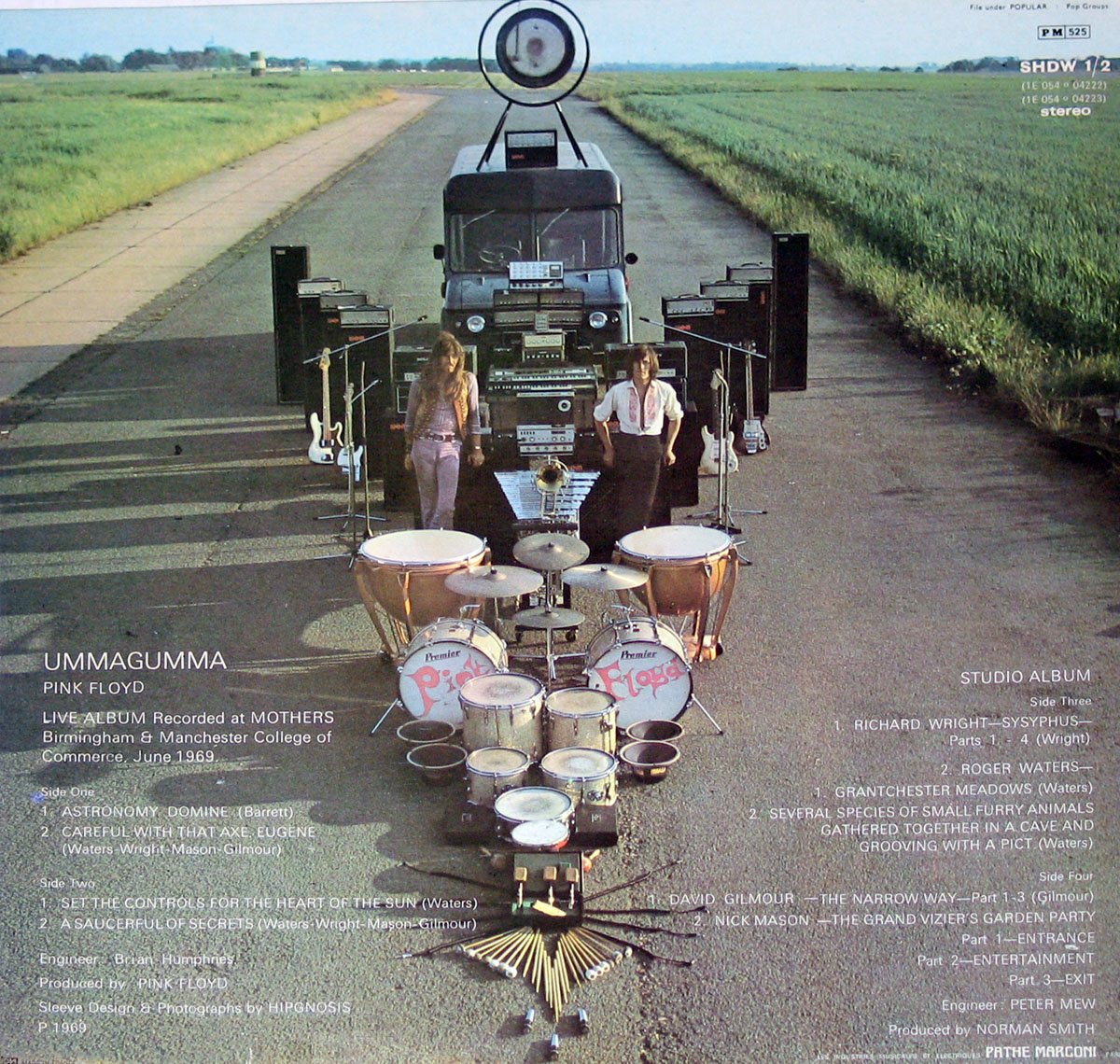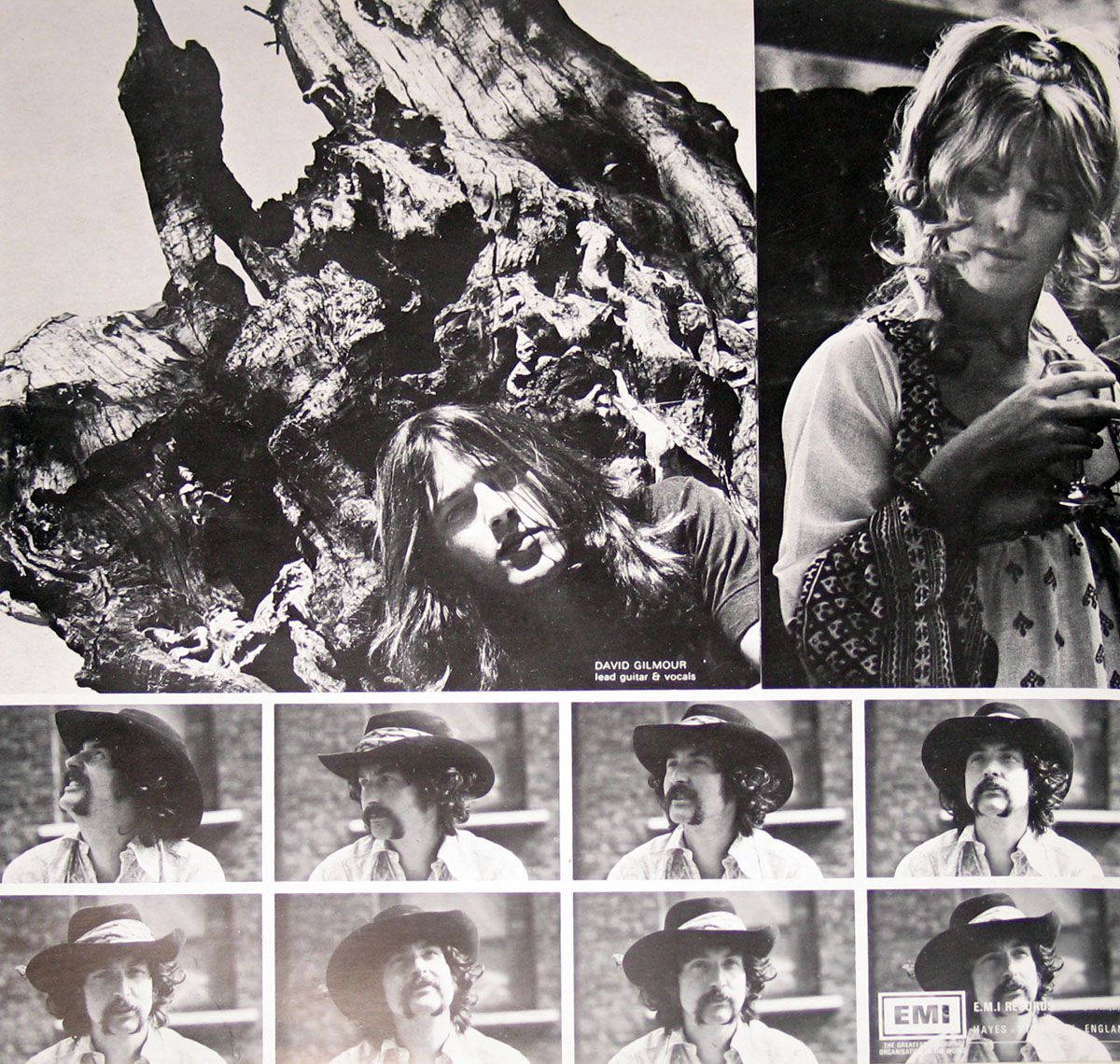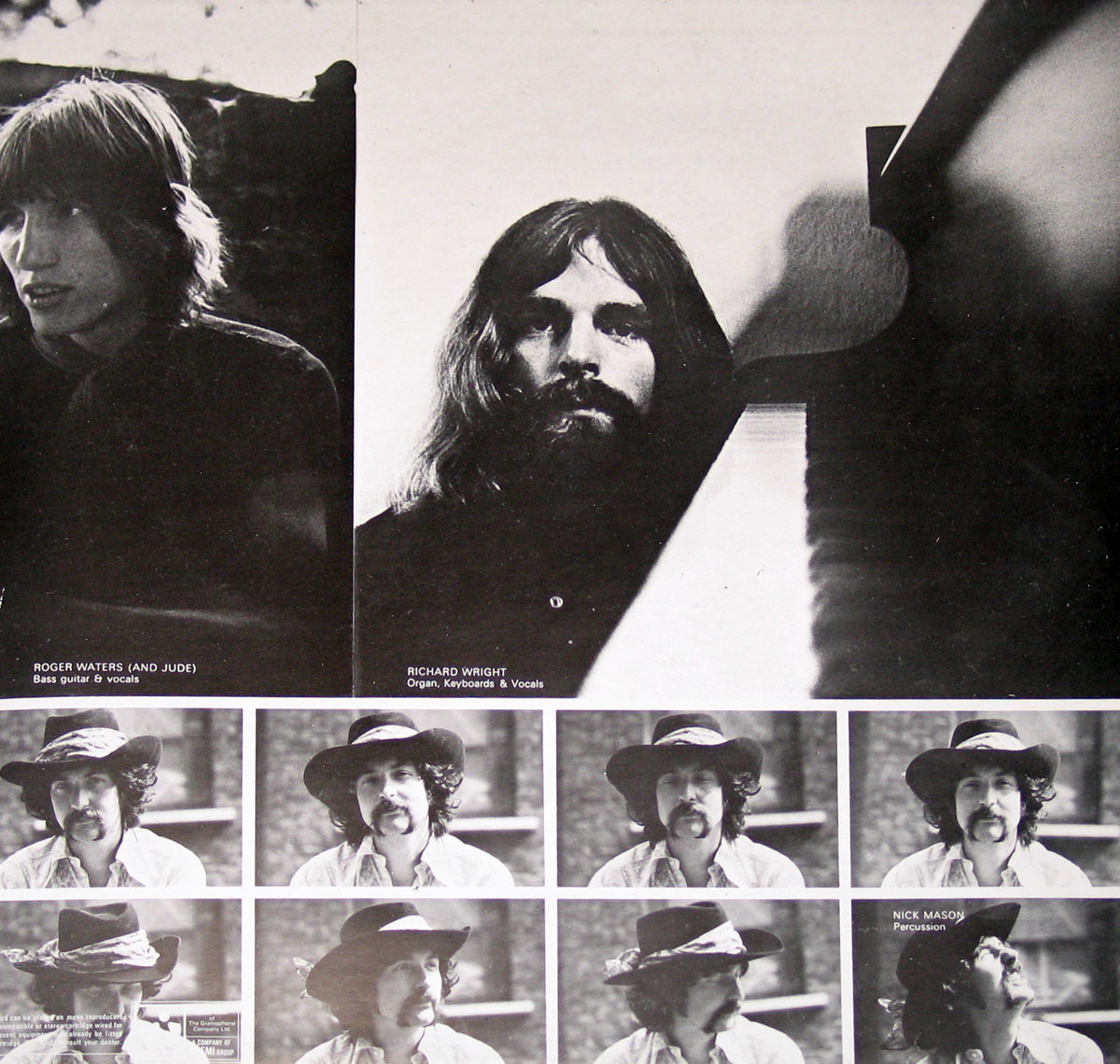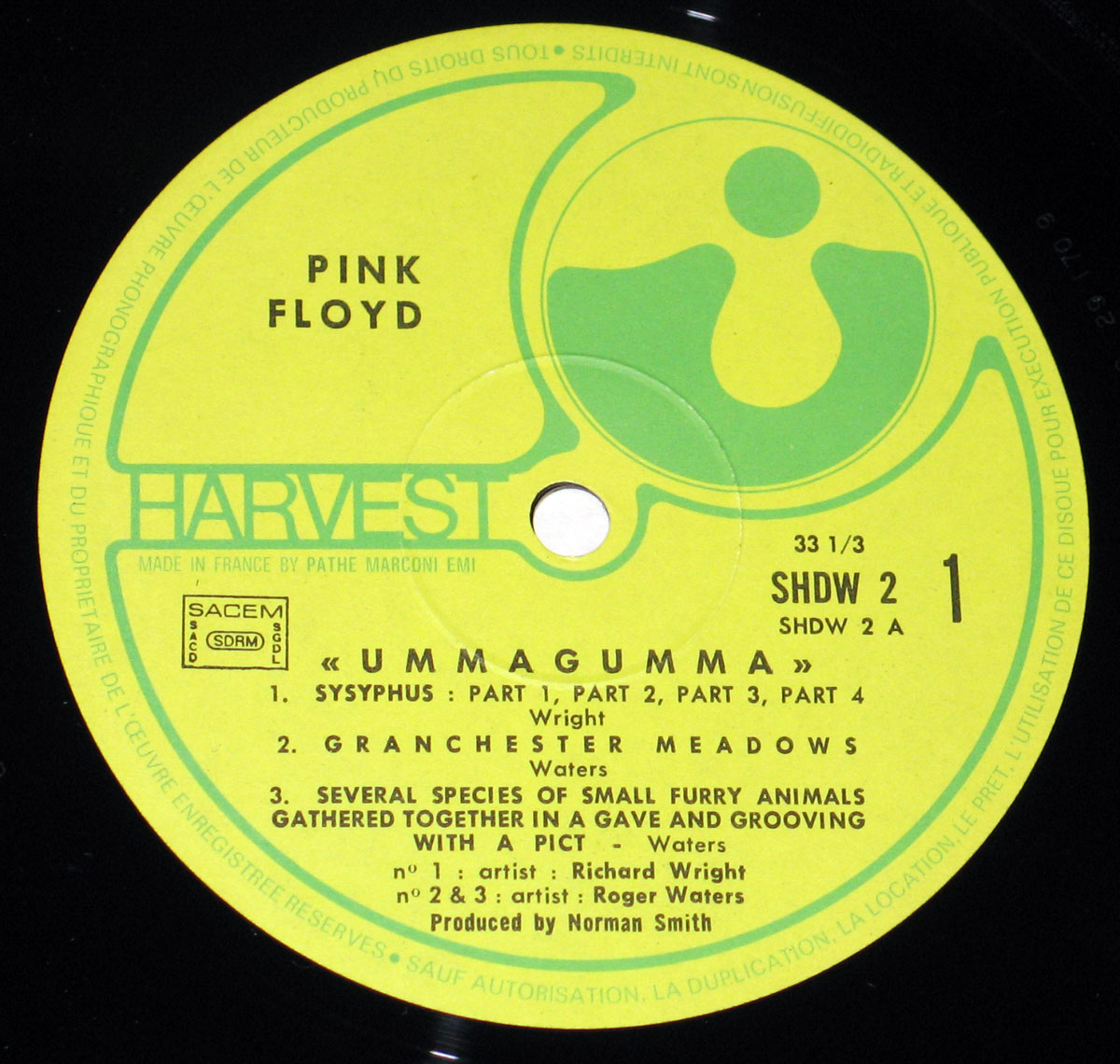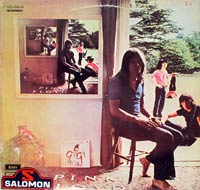"Ummagumma" Album Description:
The French release of "Ummagumma" by the iconic English Prog Rock band Pink Floyd stands as a distinctive chapter in the band's discography. Released as a 12" Vinyl 2LP Album, this version features the uncensored photo of "Gigi" on the album's front cover, creating a visually striking and controversial element.
The Gatefold/FOC (Fold Open Cover) Album Cover Design showcases the Gigi painting, adding an artistic dimension to the album's presentation. It's noteworthy that there are several versions of the Gigi cover on the front cover, each offering a unique visual experience for collectors and fans alike.
The original release with the Gigi painting on the cover captures the essence of the band's avant-garde approach and willingness to challenge conventional norms. The inclusion of an uncensored image reflects Pink Floyd's commitment to artistic expression and freedom.
In contrast, there are censored versions available. One features a white painting with no Gigi, toning down the provocative aspect of the original artwork. Another version takes a different approach by omitting the Gigi painting and it's frame entirely, leaving listeners with a more minimalistic design.
The album itself is divided into two distinct parts. Side One and Two showcase live recordings at the Mothers in Birmingham and Manchester College of Commerce in June 1969. This period marked a significant juncture in Pink Floyd's history, capturing the energy and experimentation of their live performances during that time.
On the other hand, Side Three and Four present studio recordings, displaying the band's prowess in crafting intricate studio compositions. The engineering work by Brian Humpries and Peter Mew, coupled with production by Norman Smith, contributes to the sonic richness of the studio tracks.
Sleeve Design and Photography for "Ummagumma" are credited to HIPGNOSIS, a design group known for their collaboration with numerous progressive rock bands. The visuals complement the music, creating a holistic and immersive experience for the listener.
The catalog number for this French release is Harvest SHDW 2, emphasizing its place within the Harvest Records catalog. The fact that it was made in France adds a geographical dimension to the album's history, reflecting its international influence and appeal.
Music Genre:
Psych Acid Music |
| Album Production:
Side One & Two recorded Live at the MOTHERS, Birmingham & Manchest College of Commerce June 1969,.
Side three and four recorded in the Studio. Engineers: Brian Humpries & Peter Mew.
Produced by Norman Smith
Sleeve Design and Photography: HIPGNOSIS
Hipgnosis – British album cover art design groupHipgnosis is my favorite proof that a record sleeve can be a full-on mind game, not just a band photo with better lighting. Read more... Hipgnosis is the legendary London-based art design group that turned rock sleeves into visual myths. The core duo, Storm Thorgerson and Aubrey "Po" Powell, were childhood friends of the Pink Floyd inner circle in Cambridge—a connection that allowed them to bypass the stiff mandates of EMI’s in-house design department in 1968. Their debut, "A Saucerful of Secrets," was only the second time in EMI history (after The Beatles) that an outside firm was granted creative control. The very name "Hipgnosis" was a piece of found art; Syd Barrett, during one of his more enigmatic phases, scrawled the word in ballpoint pen on the door of the South Kensington flat he shared with the duo. Thorgerson loved the linguistic friction of it: the "Hip" for the new and groovy, and "Gnosis" for the ancient, hidden knowledge. While Peter Christopherson later joined as a third partner in 1974, that initial Barrett-endorsed moniker defined a decade of surrealist mastery for bands like Led Zeppelin, Genesis, and 10cc, before the group dissolved in 1983.
|
Record Label & Catalognr:
Harvest SHDW 2 |
| Record Media Format: 12" LP Vinyl Gramophone Record |
| Country of Origin Made in France |
Band Members and Musicians on: Pink Floyd - Ummagumma uncensored Gigi France |
Pink Floyd's Band-members, Musicians and Performers
- Roger Waters - bass, vocals
- Roger Waters – Bass, vocals, songwriter
Roger Waters is the guy I blame (politely) when a Pink Floyd song stops being “spacey vibes” and starts staring straight through you with lyrics that feel like a courtroom cross-examination. Read more... Roger Waters is, to my ears, Pink Floyd’s razor-edged storyteller: bassist, singer, and the main lyric engine who pushed the band from psychedelic drift into big, human-scale themes. His key band period is Pink Floyd (1965–1985), where he became the dominant writer through the 1970s and early 1980s, before leaving and launching a long solo career (1984–present). After years of public tension, he briefly reunited with Pink Floyd for a one-off performance at Live 8 in London on 2 July 2005—basically the musical equivalent of spotting a comet: rare, bright, and gone again. Since the late 1990s he’s toured extensively under his own name, staging huge concept-driven shows that revisit Floyd classics like "The Dark Side of the Moon" (notably on the 2006–2008 tour) and "The Wall" (2010–2013), because apparently subtlety is not the point when you’ve got something to say.
- Nick Mason - percusssion
- Nick Mason – Drums, percussion
Nick Mason is the steady heartbeat I always come back to in Pink Floyd: the only constant member since the band formed in 1965, quietly holding the whole weird universe together while the rest of the planet argues about everything else. Read more... Nick Mason is Pink Floyd’s drummer, co-founder, and the one guy who never clocked out: his main performing period with Pink Floyd runs from 1965 to the present, and he’s the only member to appear across every Pink Floyd album. Outside the mothership, he’s had a very “I’m not done yet” second act: in 2018 he formed Nick Mason’s Saucerful of Secrets (2018–present) to bring the band’s early psychedelic years back to the stage. He’s also stepped out under his own name with projects like the solo album "Nick Mason’s Fictitious Sports" (released 1981), which is basically him taking a left turn into jazz-rock just to prove he can. And yes, he was part of that blink-and-you-miss-it full-band moment at Live 8 in London in 2005, when the classic lineup briefly reunited and reminded everyone why this band still haunts people.
- Dave Gilmour - Guitar, vocals
- David Gilmour – Guitar, vocals
David Gilmour is the voice-and-fingers combo I hear whenever Pink Floyd turns from “spacey” into straight-up cinematic: he joined in 1967 and basically helped define what “guitar tone with emotions” even means. Read more... David Gilmour is, for me, the calm center of Pink Floyd’s storm: an English guitarist, singer, and songwriter whose playing can feel gentle and devastating in the same bar. His earliest band period worth name-dropping is Jokers Wild (1964–1967), before he stepped into Pink Floyd in 1967 as Syd Barrett’s situation unraveled. From there his main performing era is Pink Floyd (1967–1995), including the post-Roger Waters years where the band continued under his leadership and released "A Momentary Lapse of Reason" (1987) and "The Division Bell" (1994), with a later studio coda in "The Endless River" (2014). Outside Floyd, he’s had a long solo run (1978–present) with albums ranging from "David Gilmour" (1978) to "Luck and Strange" (2024), and he even did a sharp side-quest in 1985 with Pete Townshend’s short-lived supergroup Deep End. And for one historic night, the classic lineup reunited at Live 8 in Hyde Park, London on 2 July 2005—one of those “you had to be there (or at least press play)” moments.
- Rick Wright - keyboards, vocals
- Richard Wright – Keyboards, vocals
Richard Wright is the secret atmosphere machine in Pink Floyd: the guy who can make one chord feel like a whole weather system, and then casually add a vocal harmony that makes it hit even harder. Read more... Richard Wright (born Richard William Wright) is, for me, the understated genius of Pink Floyd: co-founder, keyboardist, and occasional lead vocalist whose textures are basically baked into the band’s DNA. His main performing period with Pink Floyd runs from 1965 to 1981 (including the early albums through the massive arena years), then he returned as a full member again from 1987 to 1994 for the later era tours and albums. In between those chapters, he didn’t just vanish into a fog machine: he released a solo album, "Wet Dream" (1978), and later "Broken China" (1996), and he also had a proper side-project moment with Zee (1983–1984), which produced the album "Identity" (1984). He passed away in 2008, but his playing still feels like the part of Pink Floyd that makes the air shimmer.
|

